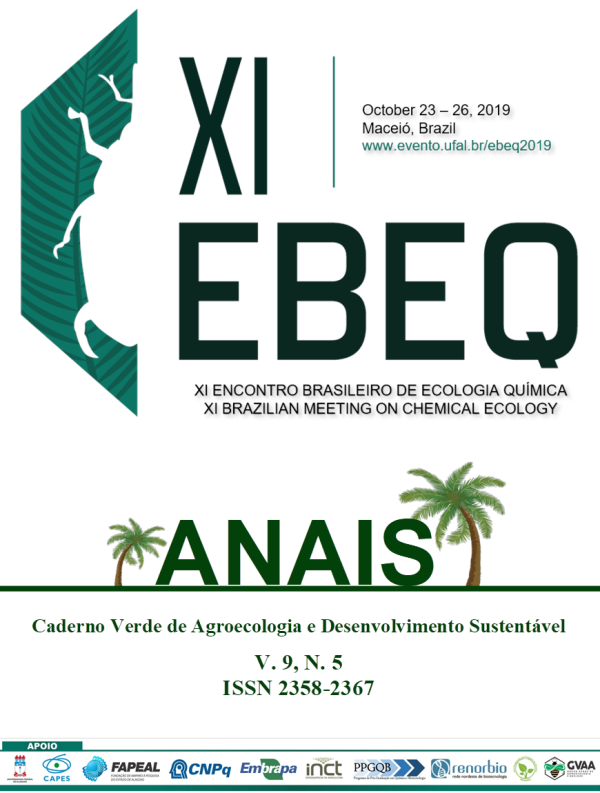CHEMICAL ECOLOGY OF THE COCONUT MOTH, Atheloca bondari Heinrich, 1956 (LEPIDOPTERA: PYRALIDAE)
Palavras-chave:
Cocos nucifera, COCONUT PEST, SEMIOCHEMICALS.Resumo
Cocos nucifera is grown in all regions of Brazil, being predominant in the northeast and is of socio-economic importance for the country. In addition to be a great economic income, C. nucifera is used as a resource by several insects, which affects its growth and causes economic losses to producers. Among these insects, the coconut moth Atheloca bondari (Lepidoptera: Pyralidae) presents a great importance in the culture. This research aimed to study the chemical ecology of the coconut moth. Female genitalia and the whole body of males and females were extracted with hexane. The extracts were analyzed by gas chromatography coupled to mass spectrometry (GC-MS) and gas chromatography coupled to flame ionization detector. When available, synthetic compounds were used to confirm the identification and to be tested in the adults antennae. Some synthetic compounds that were not identified at the extracts, but are known from pheromones of other Pyralidae species, were tested in the adults antennae. The response of the antennae of adult males and females to the extracts and synthetic compounds was tested by means electroantennography (EAG) and gas chromatography coupled to electroantennography detector (GC-EAD). It was possible to identify 23 compounds present in the female´s genitalia and 39 compounds present in the male and female cuticular by GC-MS. Female’s genitalia extracts were mainly characterized by fatty acids and alkanes and cuticular extracts were mainly characterized by linear and branched alkanes. EAG studies revealed that male antennae respond to the female cuticular extracts and to the female’s genitalia extracts. GC-EAD revealed that the male and female antennae are active to three compounds (Z9-14:CoA, Z9-14:Ald and Z9-16:OH) known from pheromone of other Phycitinae species. In addition to these compounds, additionl three not yet identified compounds elicited responses from the adults antennae of A. bondari.Downloads
Publicado
Como Citar
Edição
Seção
Licença
Termo de cessão de direitos autorias
Esta é uma revista de acesso livre, em que, utiliza o termo de cessão seguindo a lei nº 9.610/1998, que altera, atualiza e consolida a legislação sobre direitos autorais no Brasil.
O(s) autor(es) doravante designado(s) CEDENTE, por meio desta, publica a OBRA no Caderno Verde de Agroecologia e Desenvolvimento Sustentável, representada pelo Grupo Verde de Agroecologia e Abelhas (GVAA), estabelecida na Rua Vicente Alves da Silva, 101, Bairro Petrópolis, Cidade de Pombal, Paraíba, Brasil. Caixa Postal 54 CEP 58840-000 doravante designada CESSIONÁRIA, nas condições descritas a seguir:
O CEDENTE declara que é (são) autor(es) e titular(es) da propriedade dos direitos autorais da OBRA submetida.
O CEDENTE declara que a OBRA não infringe direitos autorais e/ou outros direitos de propriedade de terceiros, que a divulgação de imagens (caso as mesmas existam) foi autorizada e que assume integral responsabilidade moral e/ou patrimonial, pelo seu conteúdo, perante terceiros.
O CEDENTE mantêm os direitos autorais e concedem à revista o direito de divulgação da OBRA, com o trabalho simultaneamente licenciado sob a Licença Creative Commons do tipo atribuição CC-BY.
O CEDENTE têm autorização para distribuição não-exclusiva da versão do trabalho publicada nesta revista.
O CEDENTE têm permissão e são estimulados a publicar e distribuir seu trabalho online (ex.: em repositórios institucionais ou na sua página pessoal) a qualquer ponto antes ou durante o processo editorial, já que isso pode gerar alterações produtivas, bem como aumentar o impacto e a citação do trabalho publicado.










